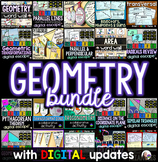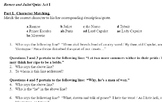28 results
Free 10th grade algebra laboratories

Population Lab: Exponential Growth and Decay
This lab is designed to give students a hands-on introduction to exponential growth and decay functions and their graphs.
Grades:
8th - 10th
Types:
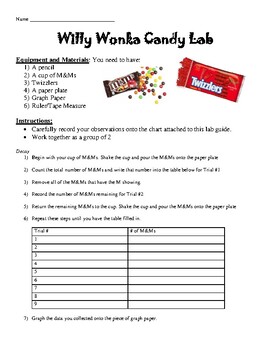
Willy Wonka Candy Lab - Exponential Growth and Decay
In this candy lab, we will be using M&M's to discover exponential growth and decay relationships. It is set up as a lab activity, so students should be able to complete this on their own. We also use Twizzlers so show an exponential decay in this lab.
Subjects:
Grades:
9th - 10th
Types:
CCSS:
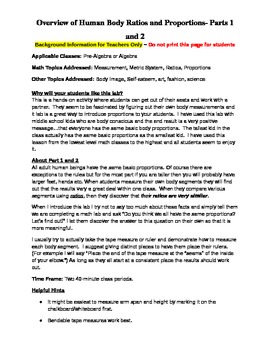
Human Body Proportions Lab Overview (To be used with my lab worksheet.)
This detailed lesson overview guides you through my other Human Body Proportions Lab that is available on TPT. This is one of my personal favorites of the entire teaching year! I have spent several years perfecting it and condensing it into a manageable lesson. Enjoy!Why will your students like this lab?This is a hands-on activity where students can get out of their seats and work with a partner. They seem to be fascinated by figuring out their own body measurements and it lab is a great way
Subjects:
Grades:
6th - 10th
Types:
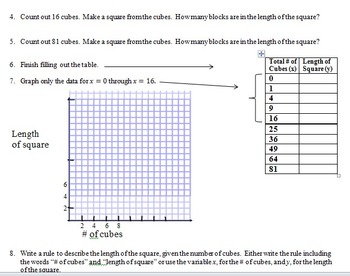
Hands-On Understanding of Square Roots: Cubes & Making Squares
This simple, hands-on activity has students count out a given number of unit cubes and then asks them to build a square from the cubes. Then, they record the length of the square. Students repeat this process with different numbers of cubes and record the information in a graph and a table. They also are asked to write a rule to describe the relationship between the number of cubes and the length of the square.
I've found that this activity helps students better understand the idea of the sq
Subjects:
Grades:
8th - 10th
Types:
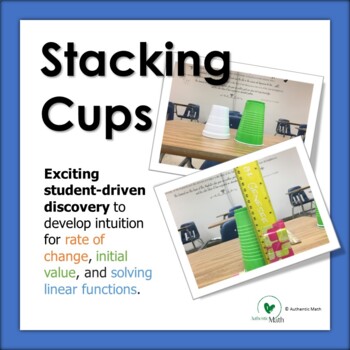
Stacking Cups - apply linear functions without even knowing it!
The question is simple: how many cups does it take to make a stack as tall as your teacher? By striving to answer this question, students develop an intuition for rate of change, initial value, and solving linear functions.Get to know Stacking Cups⭐ Student-driven discovery⭐ Perfect for groups⭐ Highly accessible⭐ Online-learning friendly⭐ Layered complexity for just the right challenge Love Stacking Cups? Follow it up with Stacking Cups Analysis for a multi-day authentic learning experience desi
Subjects:
Grades:
7th - 10th
Types:
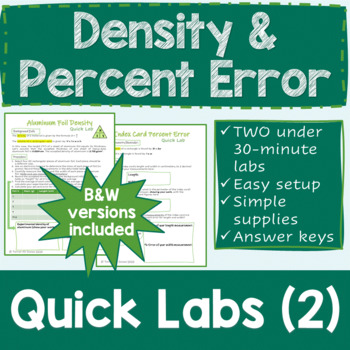
Density & Percent Error Quick Labs
Enjoy using these 2 quick labs to practice measurement skills, density calculations, and percent error any time throughout the year. In the density lab, students are asked to determine the density of aluminum by measuring the dimensions and mass of sheets of aluminum foil. In the index card lab, students calculate the area and perimeter of an index card, and determine their percent error based on the provided dimensions. Color and B&W versions included.These are considered quick labs because
Subjects:
Grades:
7th - 10th
Types:
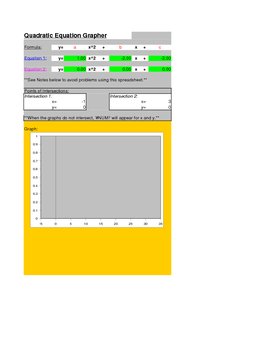
Quadratic Grapher
Quadratic Grapher MS Excel Spreadsheet graphs up to 2 quadratic equations / functions at a time. It is color coded so it is easy to see which parabola corresponds to which equation.
It also displays 10 points. The x values can be changed to your liking.
It also finds the points of intersection between the two parabolas. This is useful for solving a system of two quadratic equations. It could probably even solve a system of two equations that has one quadratic and linear equation. Just inp
Grades:
9th - 12th, Higher Education
Types:
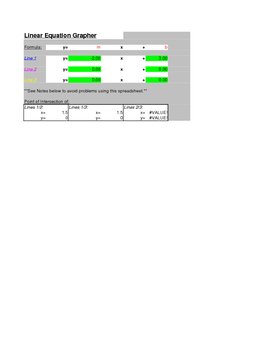
Linear Grapher
Linear Grapher Microsoft Excel Spreadsheet that allows you to graph up to 3 lines at a time. The lines are color coded with the equations, so you will know which line corresponds to which equation.
It also displays 10 points for each equation. The x values for these points can be adjusted.
It also finds the points of intersection for every pair of lines. This is helpful for system of equations.
It also has a seperate application built into the spreadsheet for finding the equation of a line
Grades:
8th - 12th, Higher Education
Types:
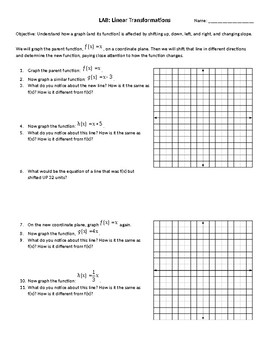
LAB: Linear Transformations
Students explore how a linear function changes (both graphically and algebraically) through observation. I highly recommend working through the first example as a class - or a similar example. But the best discussions happen when students work in groups and collaborate their hypotheses and conclusions.Feel free to make edits to adapt it to your needs! And as always, I would appreciate any feedback or ways to improve the lesson. Thank you!
Grades:
6th - 12th
Types:
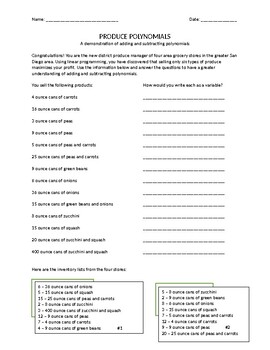
Produce Polynomials
Use a real life application of tracking the inventory of grocery stores to learn the concept of adding and subtracting polynomials. Includes a worksheet and answer key.
Subjects:
Grades:
8th - 12th
Types:
CCSS:
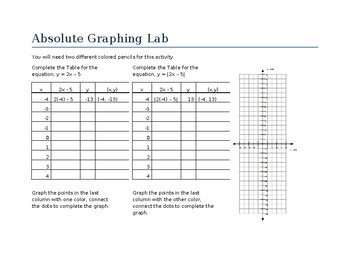
Absolute Value Graphing Lab
In this quick introductory lab, students will develop an understanding about the shape and properties of absolute value graphs by comparing contrasting similar linear and absolute value functions. Key included!
Subjects:
Grades:
7th - 12th
Types:
CCSS:

The Plumbing Problem:The Algebra Lab Manual
Maybe you are looking for an activity or lesson to give to your class before a long vacation or holiday. What about demonstrating an application of a concept just recently covered. Each Algebra Lab Manual exercise the student will be able to see the everyday application of mathematics and data analysis. The student will be able to formulate conclusions with understanding after completing each activity and provide detailed explanations for their solutions. As an option the use of spreadsheet soft
Subjects:
Grades:
7th - 11th, Adult Education
Types:

Pi Day Math Lab
This Pi Day Math Lab asks students to measure several circular objects to estimate the value of pi.
Subjects:
Grades:
7th - 12th
Types:

Electronic Student Grapher
The electronic student grapher is a simple program that can be used to demonstrate graphing linear lines and inequalities. This also can be used to allow students explore and demonstrate their ability to create graphs.
Subjects:
Grades:
7th - 12th
Types:
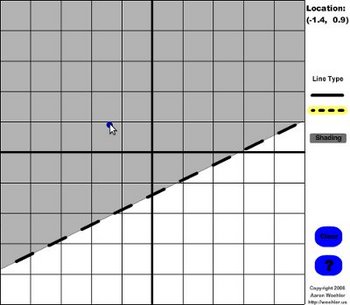
Student Line Grapher
The student line grapher is a simple flash program that can be run locally on your Windows or Mac computer. It allows students to quickly experiment with the information needed to make a line graph or inequality.
Subjects:
Grades:
5th - 11th
Types:
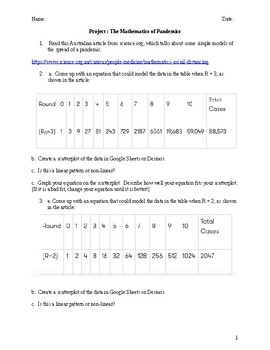
The Mathematics Of Pandemics/COVID-19
Harness the power of math to understand the spread of viruses like COVID-19. Students will make graphs and write exponential equations in order to better understand the impact of social distancing. This is a Word Document so that you can edit it to customize it for yourself as needed. Since this is a free resource, it would be wonderful if you wrote me a positive review and follow me in lieu of payment. Constructive feedback always welcome.
Subjects:
Grades:
7th - 10th
Types:

Lute Builder Project
I created this project last year to do something cross-curricular between my class (music) and the science and math teachers. Students made a lute out of simple materials and played a song after calculating fractions and ratios based on Pythagoras.
Subjects:
Grades:
9th - 12th
Types:
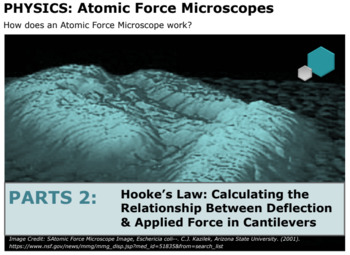
AFM: PART 2: Calculating Hooke’s Law:
DRIVING QUESTION: How does an atomic microscope work?What is an atomic force microscope (AFM), and how do they use forces to image a surface at the nanoscale? This four-part hands-on series explores the mechanics, optics, and instrumentation of an AFM. Part 1 (Understanding How Forces Impact Cantilevers & Springs) provides a qualitative exploration into the forces within a cantilever and the relationship to deflection. Part 2 (Hooke’s Law: Calculating the Relationship Between Deflection &
Grades:
9th - 12th
Types:
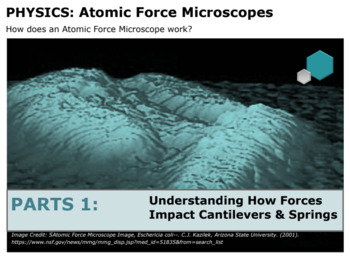
AFM: PART 1: Understanding How Forces Impact Cantilevers & Springs
DRIVING QUESTION: How does an atomic microscope work?What is an atomic force microscope (AFM), and how do they use forces to image a surface at the nanoscale? This four-part hands-on series explores the mechanics, optics, and instrumentation of an AFM. Part 1 (Understanding How Forces Impact Cantilevers & Springs) provides a qualitative exploration into the forces within a cantilever and the relationship to deflection. Part 2 (Hooke’s Law: Calculating the Relationship Between Deflection &
Grades:
9th - 12th
Types:
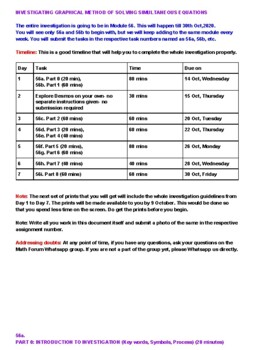
Investigating graphical method of solving equations (Grade 8/9)
This is a step by step guided enquiry document to understand what it means to solve equations graphically. All instructions that have helped me and my learners are provided in the document itself.We are mainly dealing with linear equations here, giving a glimpse of non-linear equations as well. Teachers can use this remotely to teach students new content in an exploratory manner. We are also introducing students to the usage of 'Desmos' here.
Grades:
8th - 10th
CCSS:

AFM: PART 4: Statistical Analysis with Instrumentation
DRIVING QUESTION: How does an atomic microscope work?What is an atomic force microscope (AFM), and how do they use forces to image a surface at the nanoscale? This four-part hands-on series explores the mechanics, optics, and instrumentation of an AFM. Part 1 (Understanding How Forces Impact Cantilevers & Springs) provides a qualitative exploration into the forces within a cantilever and the relationship to deflection. Part 2 (Hooke’s Law: Calculating the Relationship Between Deflection &
Grades:
9th - 12th
Types:

AFM: PARTS 1-4: Activity Sheets (ONLY)
DRIVING QUESTION: How does an atomic microscope work?What is an atomic force microscope (AFM), and how do they use forces to image a surface at the nanoscale? This four-part hands-on series explores the mechanics, optics, and instrumentation of an AFM. Part 1 (Understanding How Forces Impact Cantilevers & Springs) provides a qualitative exploration into the forces within a cantilever and the relationship to deflection. Part 2 (Hooke’s Law: Calculating the Relationship Between Deflection &
Grades:
9th - 12th
Types:

AFM: PART 3: Understanding How AFMs Use Optics & Incident Light
DRIVING QUESTION: How does an atomic microscope work?What is an atomic force microscope (AFM), and how do they use forces to image a surface at the nanoscale? This four-part hands-on series explores the mechanics, optics, and instrumentation of an AFM. Part 1 (Understanding How Forces Impact Cantilevers & Springs) provides a qualitative exploration into the forces within a cantilever and the relationship to deflection. Part 2 (Hooke’s Law: Calculating the Relationship Between Deflection &
Grades:
9th - 12th
Types:
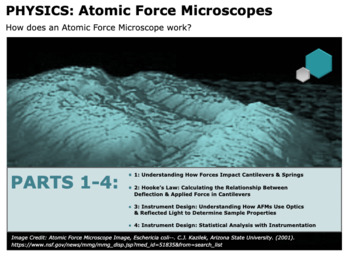
AFM: PARTS 1-4: How does an Atomic Force Microscope work?
DRIVING QUESTION: How does an atomic microscope work?What is an atomic force microscope (AFM), and how do they use forces to image a surface at the nanoscale? This four-part hands-on series explores the mechanics, optics, and instrumentation of an AFM. Part 1 (Understanding How Forces Impact Cantilevers & Springs) provides a qualitative exploration into the forces within a cantilever and the relationship to deflection. Part 2 (Hooke’s Law: Calculating the Relationship Between Deflection &
Grades:
9th - 12th
Types:
Showing 1-24 of 28 results






